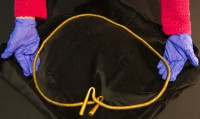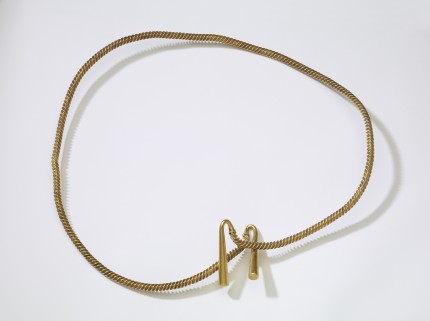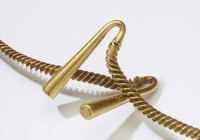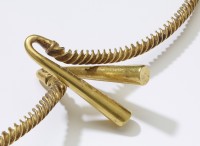 The British Museum just released its annual Treasure and Portable Antiquities Scheme report which announces archaeological findings made by members of the public in the preceding year. Among the whopping 82,272 finds reported in 2015 was a gold torc so huge it defies comprehension. Discovered by a metal detectorist on freshly ploughed farmland in East Cambridgeshire in September of last year, it is a four-flange spiral twisted bar torc dating to around 1300-1100 B.C., the Middle Bronze Age. Not counting the trumpet-shaped terminals at each end, the twisted bar is an exceptional 126.5cm (4’2″) long. The terminals are 108 and 107mm long, so just over four inches each, bringing the total length to more than 4’10”. At 732 grams (1.6 pounds) in weight, it is one of the heaviest bar torcs ever found in Britain and Ireland.
The British Museum just released its annual Treasure and Portable Antiquities Scheme report which announces archaeological findings made by members of the public in the preceding year. Among the whopping 82,272 finds reported in 2015 was a gold torc so huge it defies comprehension. Discovered by a metal detectorist on freshly ploughed farmland in East Cambridgeshire in September of last year, it is a four-flange spiral twisted bar torc dating to around 1300-1100 B.C., the Middle Bronze Age. Not counting the trumpet-shaped terminals at each end, the twisted bar is an exceptional 126.5cm (4’2″) long. The terminals are 108 and 107mm long, so just over four inches each, bringing the total length to more than 4’10”. At 732 grams (1.6 pounds) in weight, it is one of the heaviest bar torcs ever found in Britain and Ireland.
The find site is within 50 miles of Must Farm, the extraordinary bronze age village in the shadow of a chip factory on the edge of Peterborough.
“There was a lot going on in bronze age East Anglia,” said Neil Wilkin, the curator of bronze age Europe at the British Museum, “but it’s been a while since we’ve had anything as hefty as this.”
The torc is of the highest quality in materials and manufacture. It’s made of 86-87% gold and 12-13% silver (the remainder is copper), so 20-21 carat gold by modern standards. The four flanges are between 3.3 and 5mm long and are twisted counter-clockwise so expertly that the gap between them is consistently between 2.25 and 2.5mm for the entire length of the bar. Circular collars are fitted seamlessly between the bar and each terminal. How exactly they were mounted archaeologists haven’t been able to figure out yet, possibly by use of a solder with a different melting point than the gold of the bar and terminals, but tests have found no variation in the gold composition down the entire length of the torc, so if solder was used, it must have been incredibly subtle.
Torcs are usually thought of as jewelry worn around the neck, but unless there was an exceedingly wealthy and stylish Triceratops roaming around Bronze Age Cambridgeshire, this one cannot have been. It couldn’t have even been worn around someone’s waist. Because flange twisted torcs have never been found in burials, archaeologists don’t have any evidence to go on to determine how these giant torcs were worn. Suggestions include that it was worn as a sash, around the body from shoulder to hip, or possibly around the belly of a very pregnant woman as a protective talisman. It may even have adorned sacrificial sheep or goats.
The finder, who has chosen to remain anonymous, did not record the torc as he or she first found it so all experts have to go on is the finder’s vague description of it as “loosely bundled.” It was coiled but someone, and no one is naming names, opened it up into a single large loop and crossed the terminals before the discovery was reported to the Finds Liaison Officer.
The torc was reported to Helen Fowler at a finds meeting at Peterborough Museum, who said she was “gobsmacked” when it came out of the finder’s briefcase. The last torc she had handled was bracelet sized, but this one was far too big to fit on her weighing scales and she had to borrow a box from the museum to take it back to her office.
In addition to making it unwieldy, hard to weigh and materially altering a malleable, delicate archaeological treasure for no conceivable reason, the uncoiling damaged the flanges. In two places — about one third and two thirds along the length of the bar — the flanges are now distorted. In one of the spots, the edges of five twists have been scraped through the outer layer, exposing fresh gold. British Museum experts hope they’ll be able to figure out the original position of the torc at burial by examining the distorted places.
The torc has yet to be valued — a similar but smaller large-scale bar torc discovered in a bog in Northern Ireland in 2009 was valued at £150,000 — but whatever the final assessment, the Ely Museum hopes to acquire it.
Because your friendly neighborhood history blogger would never be so cruel as to report on a freaking huge gold torc without freaking huge pictures of said gold torc, your browser should probably stretch and do some light warm-ups before you click on these:


